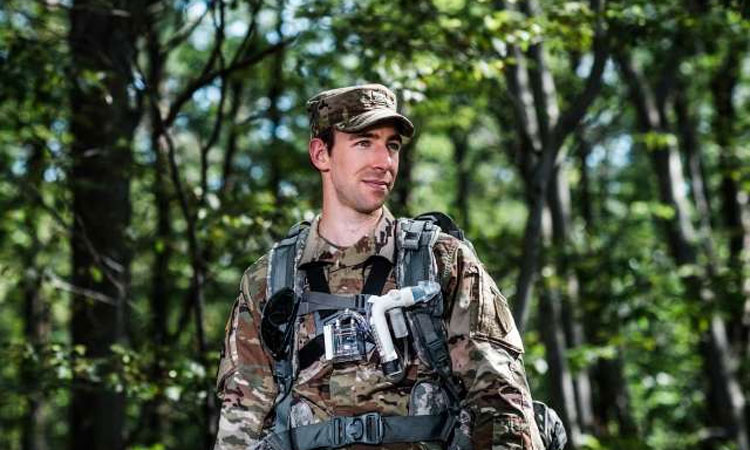Low Cost Sensor Measures Personal Metabolism
Both for optimizing the performance of warfighters under demanding physical conditions and for maintaining the health and wellness of forces during and after their military careers; the U.S. military has great interest in more comprehensive measurement and tracking of metabolism.
While sensors for making metabolic measurements have existed for decades, they are expensive, cumbersome instruments primarily intended for clinical or professional use.
MIT Lincoln Laboratory, in collaboration with the U.S. Army Research Institute for Environmental Medicine (USARIEM), has undertaken a research effort to create a low-cost personal metabolic sensor and an associated metabolic fuel model.
The Carbon dioxide/Oxygen Breath and Respiration Analyzer (COBRA) enables individuals to make on-demand metabolic measurements simply by breathing into it.
“Besides assessing performance of soldiers in the field, the COBRA can be applied to broader purposes, such as training athletes for high-endurance activities, guiding weight loss by quantifying the impact of dietary and exercise regimens, or identifying nutritional imbalances,” said Kyle Thompson, a member of the development team from Lincoln Laboratory’s Mechanical Engineering Group.
Since the early 20th Century, scientists have been using Indirect Calorimetry (IC) to calculate individual energy expenditure and metabolic rates. This method measures the ratio of carbon dioxide to oxygen in exhaled breath, which can be used to measure the levels of carbohydrates and fats being used by the body to meet metabolic energy needs.
Information about energy expenditure rates is valuable for setting reasonable physical standards within the military.
For example, limits on the distance and speed of foot marches can best be established by quantifying metabolic workloads of soldiers. The Soldier 2020 program is currently employing metabolic energy measurement to help establish job-related fitness requirements.
“For high-performance athletes or active-duty soldiers, optimally matching nutritional intake to the demands of a specific activity can improve performance and increase the likelihood of successful mission completion,” said Gary Shaw, principal investigator on the laboratory’s COBRA team.
Physically demanding tasks can lead to glycogen depletion, which has a negative impact on performance. By tracking energy expenditure in real-time, soldiers could detect and avoid the onset of low glucose levels associated with glycogen depletion as well as other metabolic complications, such as heat stress.

While existing mobile IC sensors can make physiological measurements, they are expensive and complex to calibrate since their application has largely been limited to clinical studies, high-performance athletics, and field testing with small groups of subjects over limited periods of time.
The COBRA sensor is smaller, simpler to use, and less costly to manufacture than existing IC sensors, enabling the measurement of individual energy expenditure for dozens of soldiers in a military field unit throughout the day.
Lincoln Laboratory researchers hope to use such measurements to refine the personalized metabolic fuel model for individuals, track nutritional needs, and assess the impact of training on the individual’s metabolic efficiency and endurance.
“The COBRA system is a breakthrough technology that promises to provide performance comparable to $30,000-$40,000 sensors at a fraction of the cost and with ease of use that makes personal ownership feasible,” Shaw sad.
USARIEM is currently testing and evaluating the COBRA sensor by comparing the COBRA measurements against those collected by laboratory-grade instruments.
Once the sensor performance has been benchmarked in the laboratory, USARIEM will conduct small field studies to measure energy expenditure and nutrient consumption associated with different training exercises.
Following successful field measurements, low-rate production of the COBRA sensor may be pursued in order to study energy expenditure and performance across dozens of soldiers over days of activity.
Beyond its use in studies of the performance of soldiers and athletes, the COBRA sensor and associated metabolic model can be applied to the management of the general population’s metabolic health.
It is anticipated that the COBRA sensor and metabolic model can be used to tailor dietary and exercise regimens for managing weight, inferring blood glucose and glycogen storage levels, and creating public databases on metabolic wellness and trends.
This information could be used by clinicians and patients to aid in controlling obesity, which affects over one-third of Americans, and to provide a non-invasive indication of chronically high blood glucose, which is associated with the development of type-2 diabetes.
According to the Centers for Disease Control and Prevention, nearly half of the adult population in the United States is either diabetic or pre-diabetic.
There are several promising avenues for the COBRA sensor’s future. The researchers have applied for a patent and plan to conduct single-subject experiments to demonstrate how the sensor can be used in assessing nutritional imbalances.
The laboratory will also seek opportunities to collaborate with other researchers interested in using COBRA as a tool in clinical studies, including those concerned with weight loss and endurance training.


Comments are closed, but trackbacks and pingbacks are open.